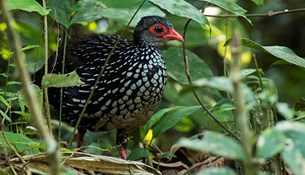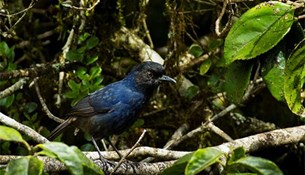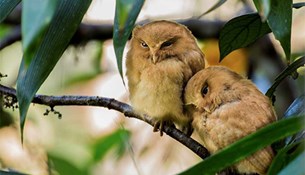Highlights
Sri Lankan endemics
Migrant birds
From rainforest to dry zone and wetlands
Leopards too
Introduction
A superb 2 weeks bird watching covering Sri Lanka's prime birding destinations in search of its endemics, resident and migrant species with one of the country's top bird guides. Of course, there is also the chance to see leopards in Yala National Park too.
Outline Itinerary
1. Depart UK.
2. Arrive Colombo, transfer to Kitugala.
3. Bird watching around forests of Kitugala.
4. To Nuwara Eliya and birding locally.
5. Excursion to Horton Plains.
6. To Tissamaharama and birdwatching in the wetlands.
7. Morning and afternoon game drives in Yala.
8. Early morning drive in Bundala, afternoon safari in Yala.
9. To Sinharaja and birding locally.
10. Full day birding in Sinharaja.
11. A further day bird watching in Sinharaja.
12. A final day birding in Sinharaja.
13. Transfer to the airport for departure.
Cost
Please contact us for prices as is it is dependent on time of year, flight costs, standard of accommodation and numbers of persons travelling.
This itinerary can be tailor made to your wishes and you might include Mirissa for a whale watching excursion or head towards the north of the island dependent on when you travel.
Departure Dates
Any day to your requirements.




Description
Sri Lanka is a biodiversity hotspot and this holds true for its bird life too. With luck and the assistance of a professional birding guide and dedicated local guides you stand a very good chance of seeing all of Sri Lanka's 34 endemic species on this private guided birdwatching holiday.
After meeting your bird guide on arrival you will head off directly to the lush forests of Kitugala. En route you may see blue-tailed bee-eater, white-throated kingfisher, white-bellied drongo, Indian roller, Sri Lanka swallow, scaly-breasted munia, brown shrike, Indian jungle crow, yellow-billed babbler, Oriental magpie-robin, and ashy woodswallow. On arrival there is a good first chance to find some of the rare endemic forest species. Your hotel for the next couple of nights is located in the woodland overlooking the Kelani River. It is an excellent place and the patches here may yield Sri Lanka green pigeon, chestnut-headed bee-eater, square-tailed bulbul, white-browed and yellow-browed bulbul, Tickell’s blue flycatcher, orange-billed babbler, Sri Lanka grey hornbill, golden-fronted leafbird, black-rumped flameback, black-headed cuckoo-shrike, Sri Lanka hill myna, common iora, purple-rumped sunbird, bar-winged flycatcher-shrike, orange minivet, brown-breasted flycatcher, Asian brown flycatcher, forest wagtail, and perhaps Layard’s Parakeet.
A full day birding might start with the chorus from spot-winged thrush or the harsher greeting of chestnut-backed owlet. Searching may also find the roost of Serendib Scops Owl. The secretive Sri Lanka spurfowl will be another target here. The crimson flameback is a gorgeous woodpecker inhabiting these forests. The Sri Lanka frogmouth may also be found.
Moving on you will climb to the tea station of Nuwara Eliya, cooler here at around 1900m. There is time after lunch to explore Victoria Park which is a prime location for Western Himalayan migrants such as the Kashmir flycatcher, pied thrush, Indian pitta, Indian blue robin, forest wagtail, Sri Lanka scimitar babbler and Syke's warbler. Your overnight accommodation is close by with wonderful views to the mountains around.
An early start with a picnic breakfast will allow you to ascend early to the heights of Horton Plains National Park. Here you will spend some time beside the track looking for montane species, Sri Lanka whistling thrush, Sri Lanka bush warbler, dull-blue flycatcher, Sri Lanka white-eye and Sri Lanka wood pigeon. Velvet-fronted nuthatch, grey-headed canary-flycatcher and bar-winged flycatcher may also be seen. Sambar abound here on the grasslands and leopard are known to prey on them here too.
Leaving the highlands you descend to Tissamaharama, here you will visit the Tissa and Deberawewa wetlands for a great number of water birds including bitterns, plovers, sandpipers, terns, ibis, egrets and herons as well as spot-billed pelican, greater flamingo, great and Indian stone-curlew. Other species might include ashy-crowned sparrow lark, brown fish owl, yellow-crowned woodpecker and Eurasian hoopoe. Nearby roost jungle owlet, Oriental scops owl and brown fish owl.
Next, you are out on safari in the bush of the dry zone forests of Yala National Park. Famous for its leopards you also have chances to see sloth bear and elephants together with many sambhar, grey langur monkeys and deer. Hopefully, having been able to watch leopards you now move on to Bundala National Park, Sri Lanka's first Ramsar site. Here you can often get close to the water birds which is great for photography. Whilst you may find many of the species seen in the Tissa area you can add to that list and may also pick up barred buttonquail, painted stork, white-bellied sea eagle, grey-headed fish eagle, greater painted-snipe, ringed plover, broad-billed sandpiper, curlew sandpiper, ruff, Terek sandpiper,
orange-breasted green pigeon, grey-bellied cuckoo, blue-faced malkoha, sirkeer malkoha, chestnut-headed bee-eater, Indian pitta, Oriental skylark, yellow-eyed babbler, rosy starling, streaked and Baya weavers, and Indian silverbill. There really is a huge list of
potential species here, and you are bound to have a great time.
The next destination is perhaps a highlight as an endemic mecca. Sinharaja and the surrounding hills boast 28 of Sri Lanka's 34 endemic species. It is also renowned for the mixed species flocks that fly through. The star of these encounters is the red-faced malkoha, a canopy dwelling bird, enigmatic and secretive you know it will be a good find! Also keep watch for Malabar trogon, white-faced starling and low down, ashy-headed laughing thrush.
For the next three days you will enjoy the birding here. The local guides that will help your expert birder guide and should be able to show you a variety of rare owls including Serendip scops owl and Sri Lanka bay owl. They can also take you to a secret location for Sri Lanka spurfowl, one of the most secretive of Sri Lanka's endemics and a big tick on a bird watching holiday to the island.
Giant squirrels also inhabit the forest together with some amazing lizards such as the hump-nosed lizard and kangaroo lizards. A number of rare amphibian species also inhabit the forest whilst butterflies and dragonflies also abound.
Eventually it is time to leave with a mind full of memories and head back to the airport for your departure flight.
This is just an example of possibilities available for holidays to the island. Please contact us for further details or to create your tailor made your holiday.